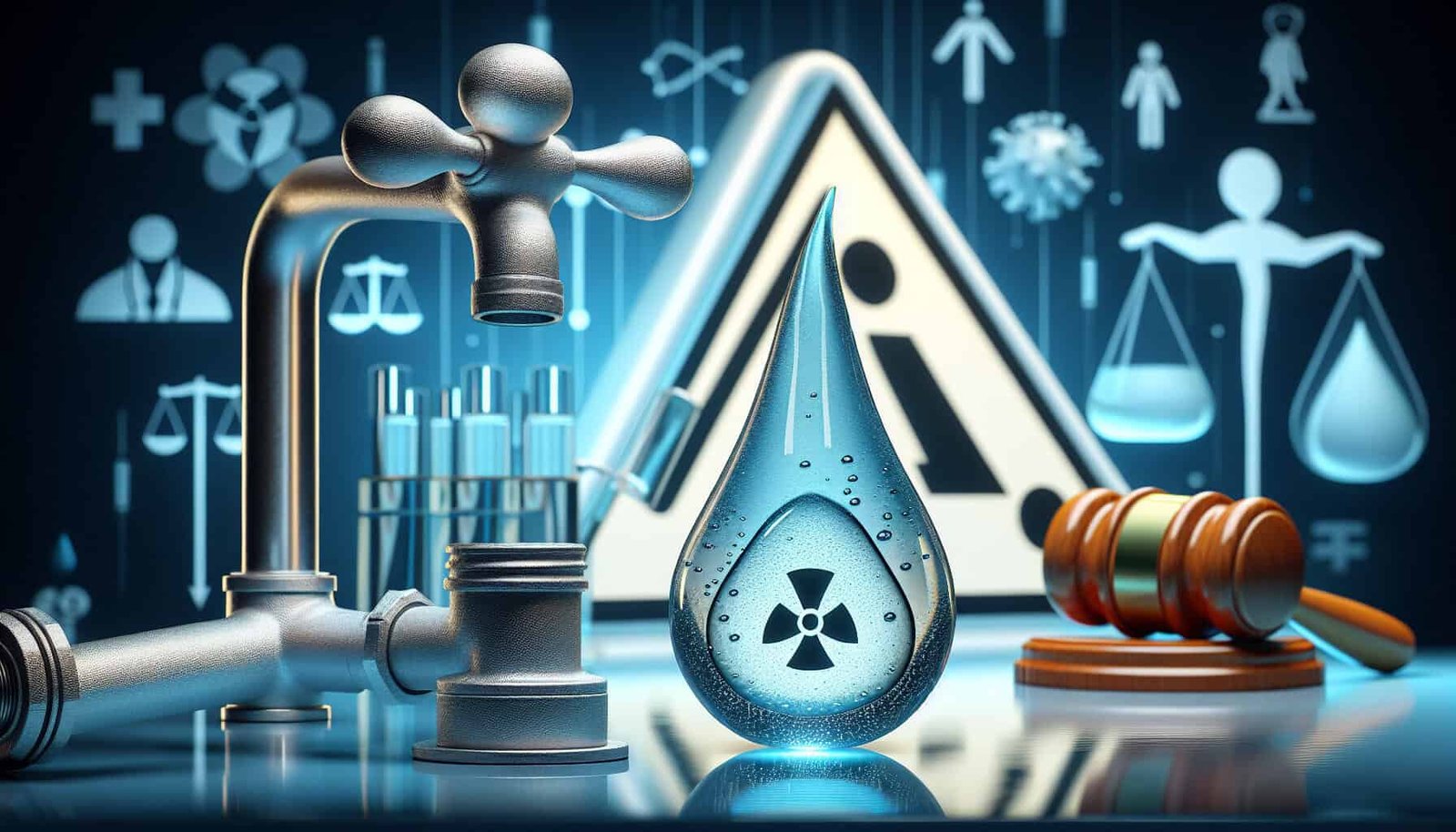In this article, we will explore whether there are any regulations in place for well water that contains elevated levels of lead-210. Lead-210, a radioactive substance, has been found in some wells, raising concerns about its potential health risks. We will look at the importance of understanding the regulations surrounding well water safety, and the potential steps individuals can take to ensure their water is safe to drink. Let’s dive into this important topic and shed some light on the regulations, or lack thereof, for well water with elevated lead-210 levels.

Overview of Lead-210 in Well Water
Lead-210 contamination in well water has become an increasing concern in recent years. Lead-210 is a naturally occurring radioactive element that can be found in rocks, soil, and minerals. As water passes through these materials, it can pick up lead-210 and carry it into wells, which are a common source of drinking water for many people. Understanding the risks associated with lead-210 contamination and implementing effective monitoring and remediation strategies has become crucial for public health and safety.
Understanding Lead-210 Contamination
Lead-210 is a known carcinogen and poses significant health risks when ingested or inhaled. Once it enters the body, it can accumulate in bones and tissues, emitting harmful ionizing radiation. The primary sources of lead-210 in well water are natural decay processes and human activities, such as mining and industrial discharges. The proximity of wells to these sources, as well as the geological composition of the area, can greatly affect lead-210 levels in the water supply.
Health Risks Associated with Lead-210
Exposure to elevated levels of lead-210 in well water can have severe health consequences. Prolonged exposure may increase the risk of developing various types of cancers, including lung, stomach, and bone cancer. Additionally, lead-210 exposure can lead to damage in vital organs, such as the liver and kidneys. Infants and young children are particularly vulnerable to the health effects of lead-210, as their bodies are still developing and their organs are more sensitive to radiation.
Current Standards and Regulations
To address the potential risks associated with lead-210 in well water, several regulations and standards have been implemented by regulatory bodies. These regulations aim to establish safe levels of lead-210 exposure and ensure the protection of public health.
Existing Regulations for Lead-210 in Well Water
The specific regulations governing lead-210 levels in well water vary across different countries and regions. In the United States, the Environmental Protection Agency (EPA) sets the Maximum Contaminant Level (MCL) for lead-210 in drinking water at 20 picocuries per liter (pCi/L). This MCL serves as a guideline to protect consumers from excessive exposure to lead-210.
Regulatory Bodies Responsible for Lead-210 Standards
The responsibility for monitoring and enforcing lead-210 standards typically lies with government agencies focused on environmental and public health. In the United States, the EPA works in collaboration with state-level agencies to regulate lead-210 levels in well water. These agencies conduct regular inspections, provide guidance, and oversee remediation efforts to ensure compliance with the established standards.

Testing and Monitoring
Regular testing and monitoring of lead-210 levels in well water are essential to identify contaminated sources and take appropriate remedial actions.
Methods for Testing Lead-210 Levels
Various methods can be used to measure lead-210 levels in well water. One commonly employed technique is the gamma spectroscopy, which detects the energy emitted by lead-210 decay products. This method provides accurate and reliable results, allowing for an assessment of the extent of lead-210 contamination.
Frequency of Testing and Monitoring
The frequency of testing and monitoring for lead-210 levels in well water depends on several factors, including the proximity to potential sources of contamination and the regulatory requirements. Regular testing is crucial, especially for wells located near industrial sites or areas with known geological characteristics that favor lead-210 accumulation. Annual testing is often recommended, but more frequent monitoring may be needed in high-risk areas.
Remediation Techniques
Once lead-210 contamination is identified in well water, several options for remediation can be considered to reduce or eliminate the presence of this radioactive element.
Options for Reducing Lead-210 Contamination
Several techniques have proven effective in reducing lead-210 levels in well water. These include ion exchange, activated carbon filtration, and reverse osmosis. Ion exchange involves removing lead-210 ions by exchanging them with less harmful ions, whereas activated carbon filtration absorbs lead-210 particles. Reverse osmosis, on the other hand, uses a semi-permeable membrane to filter out lead-210 and other contaminants.
Effectiveness of Remediation Techniques
The effectiveness of remediation techniques may vary depending on the specific situation. Factors such as the initial lead-210 concentration, water flow rate, and the chosen remediation method can impact the success of reducing lead-210 levels. It is important to consider professional advice and tailor the remediation strategy to the unique characteristics of each well.

Funding and Assistance Programs
Implementing remediation measures can be costly, and well owners may require financial support to address lead-210 contamination effectively. Governments and other organizations provide funding and assistance programs to help affected well owners with the financial burden of remediation.
Government Programs for Lead-210 Remediation
Many governments have recognized the importance of addressing lead-210 contamination and have implemented programs to support well owners in their remediation efforts. These programs may offer financial assistance, grants, or low-interest loans to help cover the costs associated with testing, monitoring, and implementing remediation measures.
Financial Assistance for Affected Well Owners
In addition to government programs, there are also non-profit organizations and foundations that provide financial assistance to well owners affected by lead-210 contamination. These organizations work towards ensuring access to clean and safe drinking water for all individuals, regardless of their financial situation.
Mitigation Strategies
Preventing lead-210 contamination in well water is crucial to safeguard public health. Several strategies can be employed to mitigate the risks of lead-210 exposure and minimize the potential for contamination.
Preventing Lead-210 Contamination in Well Water
Regular maintenance and inspection of wells are essential to prevent lead-210 contamination. Ensuring proper well construction and sealing, as well as proper placement away from potential sources of contamination, can help reduce the risk of lead-210 entering the water supply. Regular well cleaning, disinfection, and prompt repair of any leaks or damages can also minimize the potential for contamination.
Educational and Awareness Campaigns
Educational campaigns play a vital role in raising awareness about lead-210 contamination and promoting preventive measures within communities. Providing information on the risks associated with lead-210, teaching proper well maintenance practices, and disseminating knowledge about available funding and assistance programs can empower well owners to take proactive steps towards safeguarding their water supply.

Health Implications and Recommendations
Understanding the health implications of lead-210 exposure and implementing appropriate recommendations to minimize risks is crucial for protecting individuals and communities.
Risk Factors and Health Effects of Lead-210 Exposure
Exposure to elevated lead-210 levels can significantly increase the risk of developing various cancers, along with potential damage to vital organs. Individuals with prolonged exposure are particularly vulnerable to these health effects. It is important for healthcare professionals and individuals to be aware of the potential hazards and take appropriate measures to reduce exposure.
Recommendations for Individuals with Elevated Lead-210 Levels
Individuals with elevated lead-210 levels in their well water should take immediate action to mitigate the risks. This may involve implementing remediation measures, seeking medical advice, and exploring funding or assistance programs to address the contamination. Regular monitoring and testing, as well as maintaining open communication with regulatory agencies, can help ensure ongoing compliance with lead-210 standards.
Case Studies
Numerous communities have faced challenges related to lead-210 contamination in well water. Examining these case studies provides valuable insights into the response and actions taken by authorities to address the issue effectively.
Examples of Communities Affected by Lead-210 Contamination
Case studies from various regions highlight the prevalence of lead-210 contamination and the impact on affected communities. These examples illustrate the diverse causes of contamination, the challenges faced by communities, and the outcomes of remediation efforts.
Response and Actions Taken by Authorities
In response to lead-210 contamination, authorities have implemented various measures to protect public health. These include testing and monitoring initiatives, education and awareness campaigns, financial assistance programs, and the development of stricter regulations. Analyzing the response and actions taken by authorities can provide valuable lessons and knowledge for future management of lead-210 contamination.

International Perspectives
Lead-210 contamination is a global issue, and different countries have implemented their own regulations and standards to address this concern.
Regulations and Standards in Other Countries
International perspectives on lead-210 contamination reveal the diverse approaches taken by different countries to regulate and manage this issue. Some nations have adopted similar standards to the United States, while others have implemented stricter regulations to ensure enhanced protection against lead-210 exposure.
Lessons Learned from Global Efforts
International experiences offer valuable lessons for improving the management of lead-210 in well water. Knowledge sharing and collaborative efforts among countries can contribute to the development of more effective strategies, as well as the refinement of regulations and standards to address lead-210 contamination on a global scale.
Conclusion
The regulations and standards governing lead-210 in well water play a vital role in protecting public health. Understanding the risks, implementing effective testing and monitoring programs, and employing remediation techniques are all crucial for minimizing lead-210 contamination. Financial assistance programs and educational campaigns further support affected well owners in their efforts to address the issue. By learning from international experiences and continuously refining regulations, we can improve the management of lead-210 in well water and ensure the provision of clean and safe drinking water for all. It is imperative that regulatory bodies, government agencies, and individuals collaborate to achieve this goal and mitigate the potential health risks associated with lead-210 contamination. Together, we can take a proactive approach to ensure the well-being and safety of all individuals relying on well water as their primary source of drinking water.

